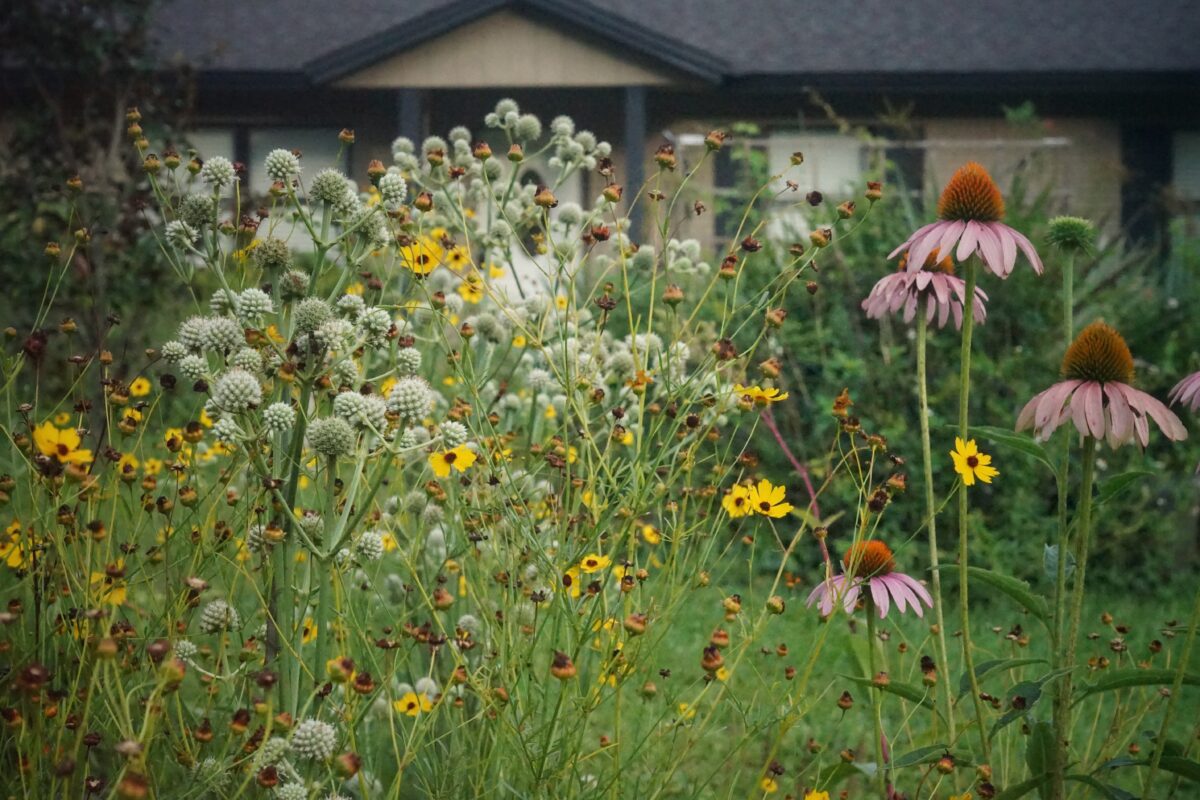It’s not a garden, it’s a habitat

by Claudia Larsen
Ecologists estimate that only 3 to 4 percent of land in the United States has been undisturbed by human activity. That’s why providing habitat — food, shelter and nesting areas for wildlife — within sustainable urban landscapes should be an important goal for everyone.
We can’t create a perfect natural habitat for each species. However, we can make a difference by using Florida’s native wildflowers and plants. Why native? Florida’s wildlife and plants evolved with each other over thousands of years. In many cases, they depend on one another for their existence.
Taking some simple steps can make your landscape a haven for birds, small mammals and a variety of other vertebrates. Call it “habitat gardening.”
Here are four easy steps you can take to create habitat for Florida’s wildlife.
Step 1: Think diversity
Provide a diversity of wildflowers that attract insects for birds, small mammals and other vertebrates. Utilize flowers with different colors, shapes and sizes to draw different pollinator species. Beneficial insects are attracted to small-flowered wildflowers like goldenrods that have dense flowerheads clustered on stems. These insects may also prey on other insects that can spread disease in your flower or vegetable garden.
Plant in clusters of up to 12 wildflowers of the same species. This will make your habitat more visible and attractive to bees and butterflies. It will also give your habitat garden a more “planned” appearance.
Step 2: Consider bloom times
To invite wildlife to your habitat every day of the year, be mindful of bloom time to provide nectar during all seasons. Different species of pollinators visit flowers in different seasons, so continuous blooming is important.
Easy spring and summer wildflowers for home landscapes include Dune sunflower (Helianthus debilis), Manyflower beardtongue (Penstemon multiflorus), Black-eyed Susan (Rudbeckia spp.), Stokes’ aster (Stokesia laevis), Tickseed (Coreopsis spp.), False petunia (Ruellia caroliniensis) and Tropical sage (Salvia coccinea).
Plant fall-blooming wildflowers to provide nectar for butterflies that fly in November and December. Spotted beebalm (Monarda punctata), Snakeroot (Ageratina jucunda), Frostweed (Verbesina virginica), Blue mistflower (Conoclinium coelestinum), Chaffhead (Carphephorus spp.), Florida sunflower (Helianthus spp.) and Cardinalflower (Lobelia cardinalis) are a few late-blooming wildflowers.
Tools to use
- Attracting Bees with Florida’s Native Wildflowers
- Attracting Birds with Florida’s Native Wildflowers
- Attracting Butterflies with Florida’s Native Wildflowers
- Guide for Choosing Native Wildflowers and Plants
- Natives for Landscaping (Florida Native Plant Society)
- Native Plants for Birds (Audubon)
- Natives for Your Neighborhood (South and Southwest Florida; Institute of Regional Conservation)
For plants, visit PlantRealFlorida.org. For seeds, visit FloridaWildflowers.com.
Step 3: Say no to neat
While letting your property grow wild is not the answer, a habitat gardener must realize that his or her landscape probably will not look tidy year-round or be low maintenance.
Selective weeding and control of vining and reseeding plants will help nip chaotic growth. But leave wildflower and grass seeds to dry on the flowerhead or shatter to the ground, because they attract many small songbirds like finches, titmice and warblers. Small songbirds love seed from Blazing star (Liatris spp.), Goldenrod (Solidago spp.), Ironweed (Vernonia spp.) and Frostweed (Verbesina virginica).
In winter, leave dormant foliage that may be hosts for insect, moth or butterfly larva. Look on the back of leaves for egg masses. Hollow stems serve as overwintering homes for larvae. Plants can be cut back in early spring to refresh foliage after insects have emerged.
Don’t apply more mulch than your habitat garden needs to suppress unwanted weeds and grasses. Use pine straw, leaves or composted wood, which will break down, providing nutrients for your plants. Leaf litter provides habitat for many arthropods, which birds adore. Leave open areas in sandy soil for ground-nesting insects and non-aggressive native bees.
Step 4: Bring on the bugs
Insects like bees, wasps, flies and beetles are indispensable to pollinate trees, shrubs, wildflowers and food plants. As they travel from plant to plant they transfer pollen from stamens that ensures seed formation.
Insects and spiders are attracted to wildflowers for nectar, cover and places to lay eggs. You may think you would rather not have more insects in your habitat garden, but insects provide a high-protein food for many birds, reptiles and mammals. They also help provide soil nutrients by breaking down leaf litter, wood and dung.
With a bit of research, you can attract more species of butterflies by providing their wildflower host plants, which are essential for laying eggs and nourishing larvae. Watching the metamorphosis process in your own yard is remarkable.
Caterpillars may be unpopular when they strip leaves from plants, but birds and other animals gain important nutrients from eating them. Consider this: Bringing Nature Home author Doug Tallamy writes that a pair of chickadees must provide 6,000 to 9,000 caterpillars to raise just one clutch of young.
When inviting insects into your yard, nix the use of pesticides, especially those containing neonicotinoids. Many scientific studies have shown that “neonics” are harmful to bees. They’re thought to be part of the reason honey bee populations have plummeted.
The last word
It is important to choose plants that are adapted to your environmental conditions and growing range. You will be more successful if you spend a little time investigating plant materials and preparing a plant list with diversity in growth habit and bloom times.
Learning interdependence of plants and animals can become a consuming passion and the source of one amazing realization after another. Enjoy!
Claudia Larsen is the Florida Wildflower Foundation’s Seedlings for Schools program manager. She owns Micanopy Wildflowers nursery in Micanopy, Fla.
